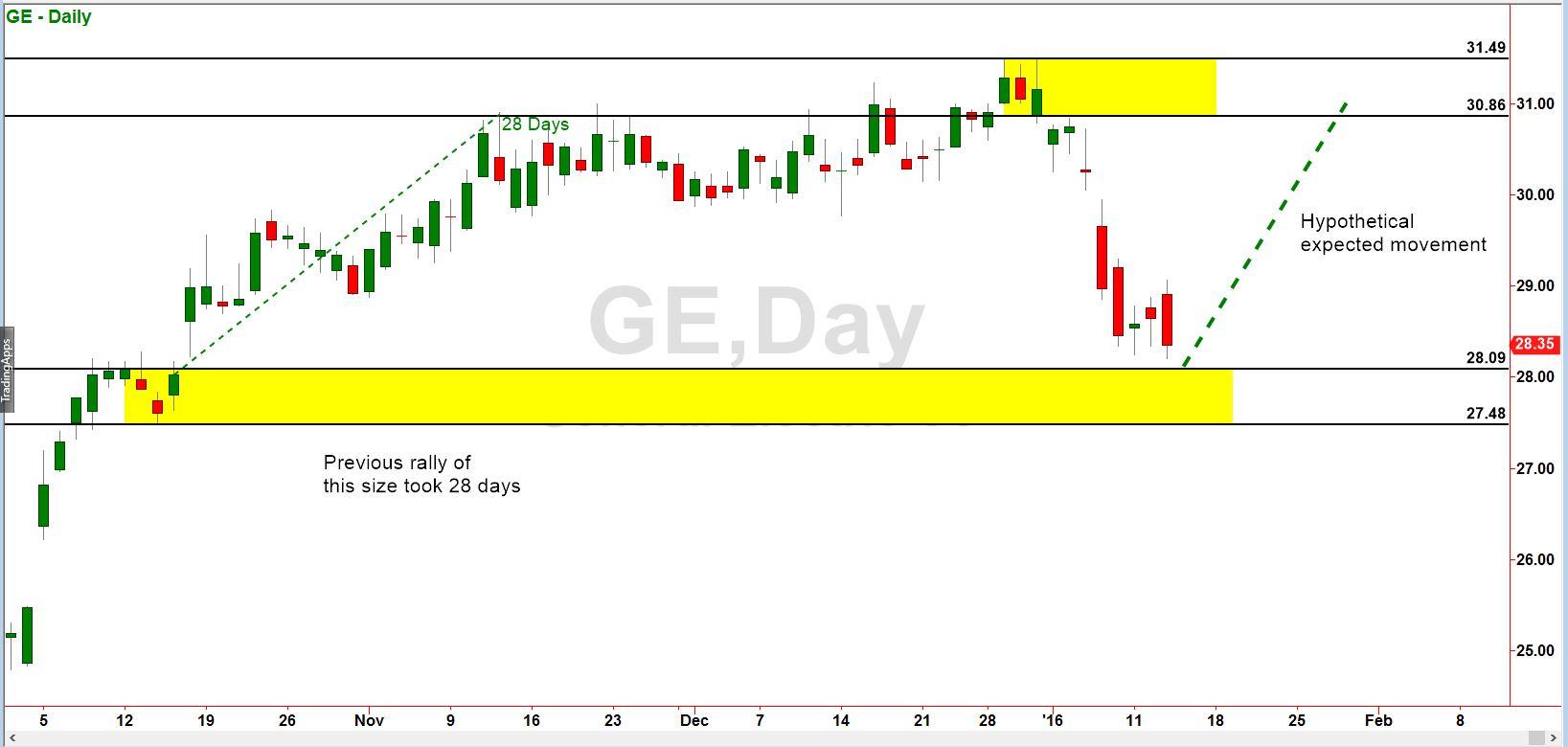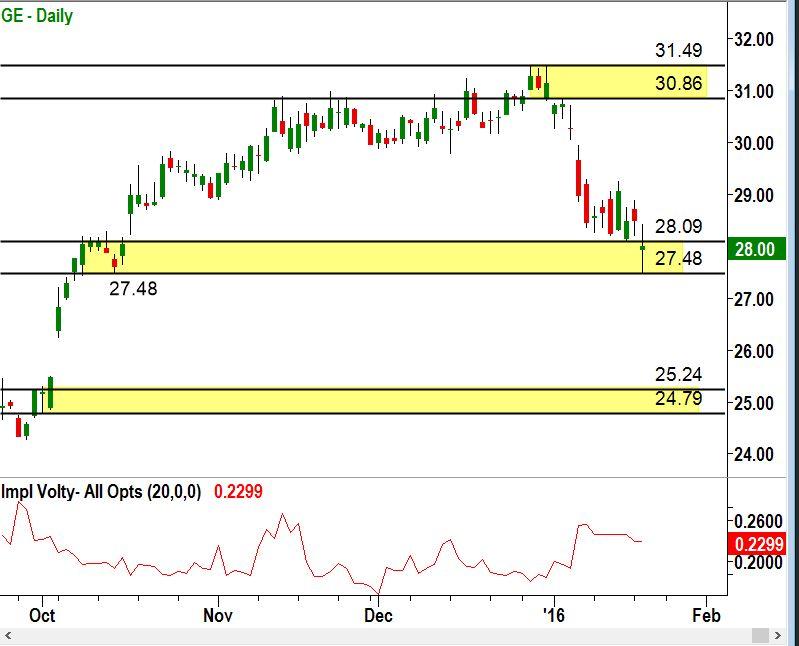-------
Who were the best experts in 2015? Have your say and vote for FXStreet's Forex Best Awards 2016! Cast your vote now!
-------
In part one of this series I went over the types of options expiration dates. In the second and third parts, we continued with a discussion of the option chain and ‘time in the trade’.
In this series, I have been using the stock of General Electric as an example. Here is its chart as it appeared on January 13:
We were looking at this as a bullish example, discussing which expirations to choose for call options.
In the last paragraph of part 3, I said “Finally, we should consider the question of whether, in this circumstance, we would want to be buying call options at all. We could also make money from this move by selling put options short instead. That is a choice that we would make based on whether options were underpriced or overpriced.”
Today we’ll look at that further.
This is a chart of GE as of today, January 20, 2016:
The area of demand that we had identified earlier from $27.48 to $28.09 had so far held up. Coincidentally (or not), the lowest price reached before a bounce today was exactly $27.48, the lower bound of our previously identified demand zone. If we had the nerve for it, this was still a possible bullish play.
The two simplest possible option trades for a bullish situation are buying call options or selling short put options. We discussed buying calls last time and explained why we would want to look for options with an expiration a few months away when buying.
Note the indicator in the bottom of the above chart. This is Implied Volatility, which is an indication of over- or under-pricing of options. The current reading was quite high indicating that options were expensive. When that is the case, then being a short seller of options, rather than a buyer, is indicated.
Let’s say that we decided selling put options was out best choice. The plan would be to collect money for selling the options now to people who believed that GE was going lower; and then wait for the options to become worthless when GE did not go lower.
When we use this kind of plan, we want the options to be in the last few weeks of their life. That is when their value drops fastest. Remember that when buying calls we specifically did not want to own the options in the last few weeks of their life, and for the same reason. A good time to be short is a bad time to be long.
Since the February cycle ends on February 19, thirty days away, that would be a good choice for an expiration date.
For strike prices, we had a couple of alternatives. The 27 strike would be a bold choice. The February 27 puts could be sold for about $.60 per share. The investment required would be a $27 per share cash deposit. A sixty cent return on $27.00 is about a 2.2% return in a month, or 26.7% annualized. This would be our return on investment as long as GE was not below $27 on February 19. If it was lower than that, then we would be forced to pay $27 a share for it. After deducting the $.60 received for the puts, our net cost would be $26.40 per share, which would be our break-even price.
Using the near-term puts in this situation would give us a greater profit per day, as all options lose their time value at an ever-increasing rate. The March $27 puts, for example, with 57 days to go, could be sold for about $.91. That was a daily rate of return of $.91 / 57 = $1.59 per day. The February 27 puts described above, by comparison, would make $.60 in 30 days, or exactly $2.00 per day.
The shorter life of the near-term options also means that there is less time for the trade to go wrong. With short option trades, we want the clock to run out without the stock passing the strike price. The less time there is the better chance we have.
In terms of strike price selection, our second more conservative alternative was to sell puts at a $25 strike price. That would put the strike below the next lower level of demand ($24.79-25.24 on the chart). The February $25 puts could be sold for about 25 cents, which was one percent of the strike price. Our return would thus be 1% in a month, or 12% annualized (If GE did not drop below $25).
With the $25 puts, if GE should drop from its current level, it would have to fall all the way to $25 before our maximum profit was threatened. In the worst case, we would own the stock at a net cost of $25.00 – $.25 = $24.75 per share.
Whether we choose to be conservative or aggressive in selecting our strikes, the right choice of expirations is also crucial. The basic rule is to buy longer expirations, but sell shorter expirations. This allows us to be hurt the least (in the case of long options) or helped the most (in the case of short options) by the inexorable decay of time value.
This content is intended to provide educational information only. This information should not be construed as individual or customized legal, tax, financial or investment services. As each individual's situation is unique, a qualified professional should be consulted before making legal, tax, financial and investment decisions. The educational information provided in this article does not comprise any course or a part of any course that may be used as an educational credit for any certification purpose and will not prepare any User to be accredited for any licenses in any industry and will not prepare any User to get a job. Reproduced by permission from OTAcademy.com click here for Terms of Use: https://www.otacademy.com/about/terms
Editors’ Picks
EUR/USD clings to daily gains above 1.0650

EUR/USD gained traction and turned positive on the day above 1.0650. The improvement seen in risk mood following the earlier flight to safety weighs on the US Dollar ahead of the weekend and helps the pair push higher.
GBP/USD recovers toward 1.2450 after UK Retail Sales data

GBP/USD reversed its direction and advanced to the 1.2450 area after touching a fresh multi-month low below 1.2400 in the Asian session. The positive shift seen in risk mood on easing fears over a deepening Iran-Israel conflict supports the pair.
Gold holds steady at around $2,380 following earlier spike

Gold stabilized near $2,380 after spiking above $2,400 with the immediate reaction to reports of Israel striking Iran. Meanwhile, the pullback seen in the US Treasury bond yields helps XAU/USD hold its ground.
Bitcoin Weekly Forecast: BTC post-halving rally could be partially priced in Premium

Bitcoin price shows no signs of directional bias while it holds above $60,000. The fourth BTC halving is partially priced in, according to Deutsche Bank’s research.
Week ahead – US GDP and BoJ decision on top of next week’s agenda

US GDP, core PCE and PMIs the next tests for the Dollar. Investors await BoJ for guidance about next rate hike. EU and UK PMIs, as well as Australian CPIs also on tap.
RECOMMENDED LESSONS
Making money in forex is easy if you know how the bankers trade!
Discover how to make money in forex is easy if you know how the bankers trade!
5 Forex News Events You Need To Know
In the fast moving world of currency markets, it is extremely important for new traders to know the list of important forex news...
Top 10 Chart Patterns Every Trader Should Know
Chart patterns are one of the most effective trading tools for a trader. They are pure price-action, and form on the basis of underlying buying and...
7 Ways to Avoid Forex Scams
The forex industry is recently seeing more and more scams. Here are 7 ways to avoid losing your money in such scams: Forex scams are becoming frequent. Michael Greenberg reports on luxurious expenses, including a submarine bought from the money taken from forex traders. Here’s another report of a forex fraud. So, how can we avoid falling in such forex scams?
What Are the 10 Fatal Mistakes Traders Make
Trading is exciting. Trading is hard. Trading is extremely hard. Some say that it takes more than 10,000 hours to master. Others believe that trading is the way to quick riches. They might be both wrong. What is important to know that no matter how experienced you are, mistakes will be part of the trading process.


